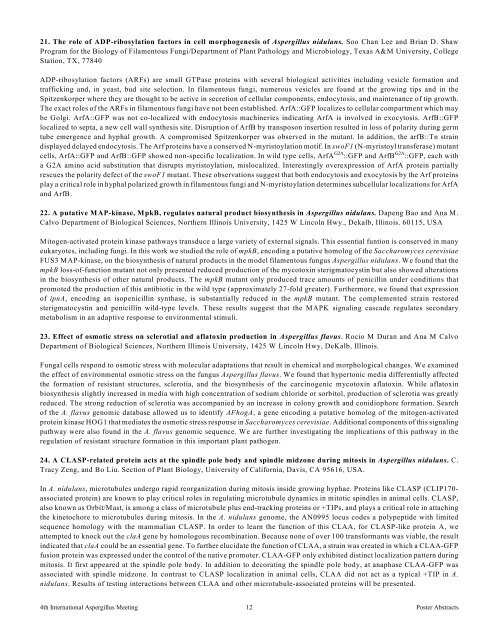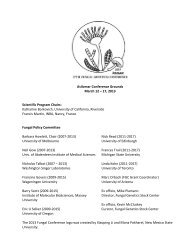Asperfest 4 Program - Fungal Genetics Stock Center
Asperfest 4 Program - Fungal Genetics Stock Center
Asperfest 4 Program - Fungal Genetics Stock Center
You also want an ePaper? Increase the reach of your titles
YUMPU automatically turns print PDFs into web optimized ePapers that Google loves.
21. The role of ADP-ribosylation factors in cell morphogenesis of Aspergillus nidulans. Soo Chan Lee and Brian D. Shaw<br />
<strong>Program</strong> for the Biology of Filamentous Fungi/Department of Plant Pathology and Microbiology, Texas A&M University, College<br />
Station, TX, 77840<br />
ADP-ribosylation factors (ARFs) are small GTPase proteins with several biological activities including vesicle formation and<br />
trafficking and, in yeast, bud site selection. In filamentous fungi, numerous vesicles are found at the growing tips and in the<br />
Spitzenkorper where they are thought to be active in secretion of cellular components, endocytosis, and maintenance of tip growth.<br />
The exact roles of the ARFs in filamentous fungi have not been established. ArfA::GFP localizes to cellular compartment which may<br />
be Golgi. ArfA::GFP was not co-localized with endocytosis machineries indicating ArfA is involved in exocytosis. ArfB::GFP<br />
localized to septa, a new cell wall synthesis site. Disruption of ArfB by transposon insertion resulted in loss of polarity during germ<br />
tube emergence and hyphal growth. A compromised Spitzenkorper was observed in the mutant. In addition, the arfB::Tn strain<br />
displayed delayed endocytosis. The Arf proteins have a conserved N-myristoylation motif. In swoF1 (N-myristoyl transferase) mutant<br />
G2A<br />
G2A<br />
cells, ArfA::GFP and ArfB::GFP showed non-specific localization. In wild type cells, ArfA ::GFP and ArfB ::GFP, each with<br />
a G2A amino acid substitution that disrupts myristoylation, mislocalized. Interestingly overexpression of ArfA protein partially<br />
rescues the polarity defect of the swoF1 mutant. These observations suggest that both endocytosis and exocytosis by the Arf proteins<br />
play a critical role in hyphal polarized growth in filamentous fungi and N-myristoylation determines subcellular localizations for ArfA<br />
and ArfB.<br />
22. A putative MAP-kinase, MpkB, regulates natural product biosynthesis in Aspergillus nidulans. Dapeng Bao and Ana M.<br />
Calvo Department of Biological Sciences, Northern Illinois University, 1425 W Lincoln Hwy., Dekalb, Illinois. 60115, USA<br />
Mitogen-activated protein kinase pathways transduce a large variety of external signals. This essential funtion is conserved in many<br />
eukaryotes, including fungi. In this work we studied the role of mpkB, encoding a putative homolog of the Saccharomyces cerevisiae<br />
FUS3 MAP-kinase, on the biosynthesis of natural products in the model filamentous fungus Aspergillus nidulans. We found that the<br />
mpkB loss-of-function mutant not only presented reduced production of the mycotoxin sterigmatocystin but also showed alterations<br />
in the biosynthesis of other natural products. The mpkB mutant only produced trace amounts of penicillin under conditions that<br />
promoted the production of this antibiotic in the wild type (approximately 27-fold greater). Furthermore, we found that expression<br />
of ipnA, encoding an isopenicillin synthase, is substantially reduced in the mpkB mutant. The complemented strain restored<br />
sterigmatocystin and penicillin wild-type levels. These results suggest that the MAPK signaling cascade regulates secondary<br />
metabolism in an adaptive response to environmental stimuli.<br />
23. Effect of osmotic stress on sclerotial and aflatoxin production in Aspergillus flavus. Rocio M Duran and Ana M Calvo<br />
Department of Biological Sciences, Northern Illinois University, 1425 W Lincoln Hwy, DeKalb, Illinois.<br />
<strong>Fungal</strong> cells respond to osmotic stress with molecular adaptations that result in chemical and morphological changes. We examined<br />
the effect of environmental osmotic stress on the fungus Aspergillus flavus. We found that hypertonic media differentially affected<br />
the formation of resistant structures, sclerotia, and the biosynthesis of the carcinogenic mycotoxin aflatoxin. While aflatoxin<br />
biosynthesis slightly increased in media with high concentration of sodium chloride or sorbitol, production of sclerotia was greatly<br />
reduced. The strong reduction of sclerotia was accompanied by an increase in colony growth and conidiophore formation. Search<br />
of the A. flavus genomic database allowed us to identify AFhogA, a gene encoding a putative homolog of the mitogen-activated<br />
protein kinase HOG1 that mediates the osmotic stress response in Saccharomyces cerevisiae. Additional components of this signaling<br />
pathway were also found in the A. flavus genomic sequence. We are further investigating the implications of this pathway in the<br />
regulation of resistant structure formation in this important plant pathogen.<br />
24. A CLASP-related protein acts at the spindle pole body and spindle midzone during mitosis in Aspergillus nidulans. C.<br />
Tracy Zeng, and Bo Liu. Section of Plant Biology, University of California, Davis, CA 95616, USA.<br />
In A. nidulans, microtubules undergo rapid reorganization during mitosis inside growing hyphae. Proteins like CLASP (CLIP170-<br />
associated protein) are known to play critical roles in regulating microtubule dynamics in mitotic spindles in animal cells. CLASP,<br />
also known as Orbit/Mast, is among a class of microtubule plus end-tracking proteins or +TIPs, and plays a critical role in attaching<br />
the kinetochore to microtubules during mitosis. In the A. nidulans genome, the AN0995 locus codes a polypeptide with limited<br />
sequence homology with the mammalian CLASP. In order to learn the function of this CLAA, for CLASP-like protein A, we<br />
attempted to knock out the claA gene by homologous recombination. Because none of over 100 transformants was viable, the result<br />
indicated that claA could be an essential gene. To further elucidate the function of CLAA, a strain was created in which a CLAA-GFP<br />
fusion protein was expressed under the control of the native promoter. CLAA-GFP only exhibited distinct localization pattern during<br />
mitosis. It first appeared at the spindle pole body. In addition to decorating the spindle pole body, at anaphase CLAA-GFP was<br />
associated with spindle midzone. In contrast to CLASP localization in animal cells, CLAA did not act as a typical +TIP in A.<br />
nidulans. Results of testing interactions between CLAA and other microtubule-associated proteins will be presented.<br />
4th International Aspergillus Meeting 12 Poster Abstracts











